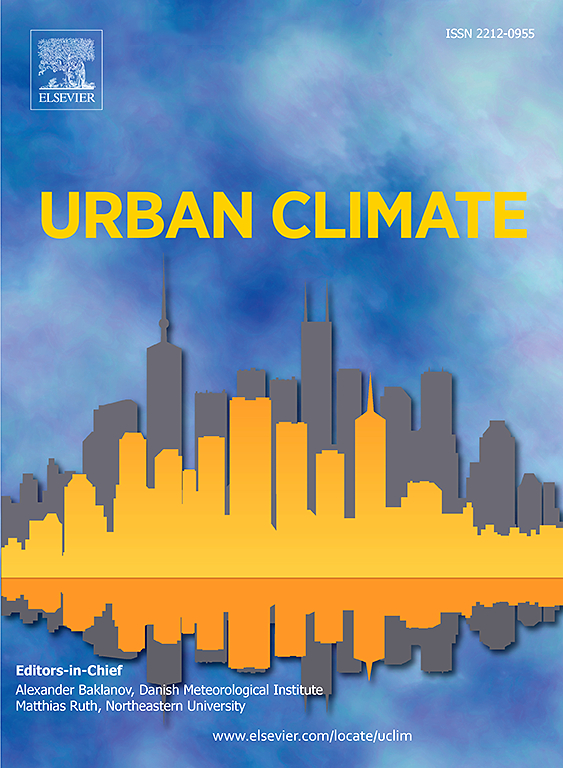高温天气期间城市屋顶降温策略的降温效应时空分布--沿海大都市东京的案例研究
IF 6
2区 工程技术
Q1 ENVIRONMENTAL SCIENCES
引用次数: 0
摘要
在全球变暖的情况下,屋顶减缓策略(RMS)可以缓解高度城市化城市的极端热量。在这项研究中,将沿海大都市东京的网格化城市冠层参数与多层城市冠层模型整合到天气研究与预报模型中。然后分析了屋顶光伏板、沉香绿化屋顶和草坪绿化屋顶对高温天城市热环境的影响。在下午 2 点、上午 10 点和中午 12 点,光伏板、沉香绿化屋顶和覆盖率为 50% 的草坪绿化屋顶可显著降低区域平均行人水平气温,分别降低了 0.10 °C、0.11 °C 和 0.13 °C。所有 RMS 的区域最大降温效应的日峰值出现在下午 2 点左右,分别达到 0.25 °C、0.25 °C 和 0.30 °C。尽管白天有降温效应,但两种降温模式都会增加热应力,草地降温模式尤为明显,因为其蒸发能力更强,导致约 75% 的研究区域的 WBGT 上升达 0.15 °C。此外,沿海地区的 RMSs 影响延伸至西北腹地,表明受海风平流影响的非本地模式。此外,在高温条件下,正午的降温效应随背景温度的升高而线性增加。本文章由计算机程序翻译,如有差异,请以英文原文为准。
Spatiotemporal distribution of cooling effects from urban-scale rooftop mitigation strategies during high-temperature weather—A case study of the coastal Metropolis Tokyo
Rooftop mitigation strategies (RMSs) can alleviate extreme heat in highly urbanized cities under global warming. In this study, gridded urban canopy parameters for Tokyo, a coastal metropolis, were integrated into the Weather Research and Forecasting model, coupled with a multilayer urban canopy model. The effects of rooftop photovoltaic (PV) panels, sedum green roofs (GRs), and grass GRs on the urban thermal environment during high-temperature days were then analyzed. PV panels, sedum GR, and grass GR with 50 % coverage achieved the most significant reductions in regional average pedestrian-level air temperatures at 2 PM, 10 AM, and 12 PM, respectively, with reductions of 0.10 °C, 0.11 °C, and 0.13 °C. The daily peak of regional maximum cooling effects for all RMSs were observed around 2 PM, reaching 0.25 °C, 0.25 °C, and 0.30 °C, respectively. Despite the daytime cooling effect, both GRs increased heat stress, which was particularly noticeable in grass GRs due to their stronger evaporative capacity, resulting in an increase in WBGT of up to 0.15 °C in approximately 75 % of the study areas. Additionally, the impacts of RMSs in coastal areas extended to the northwestern hinterland, indicating a non-local pattern influenced by sea-breeze advection. Furthermore, under high-temperature conditions, the cooling effect of GRs at midday increased linearly with background temperature.
求助全文
通过发布文献求助,成功后即可免费获取论文全文。
去求助
来源期刊

Urban Climate
Social Sciences-Urban Studies
CiteScore
9.70
自引率
9.40%
发文量
286
期刊介绍:
Urban Climate serves the scientific and decision making communities with the publication of research on theory, science and applications relevant to understanding urban climatic conditions and change in relation to their geography and to demographic, socioeconomic, institutional, technological and environmental dynamics and global change. Targeted towards both disciplinary and interdisciplinary audiences, this journal publishes original research papers, comprehensive review articles, book reviews, and short communications on topics including, but not limited to, the following:
Urban meteorology and climate[...]
Urban environmental pollution[...]
Adaptation to global change[...]
Urban economic and social issues[...]
Research Approaches[...]
 求助内容:
求助内容: 应助结果提醒方式:
应助结果提醒方式:


